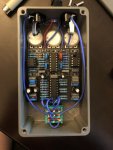absolvism
Member
Hello!
I just finished building a Dark Rift, and everything seems to be working... except the repeated/wet/delay signal has a distortion/fuzz in it..
So the first pluck always sounds normal, but then all the succeeding delay signal has a very pronounced fuzzy/scratchy undertone to the whole thing. I've tried different amps and cables and it appears that it's definitely in the pedal itself. If I set the mix to 100% dry, there is no fuzz, it's just in the wet.
Besides pulling the whole thing apart and starting over, does anyone have any ideas or directions to troubleshoot that they might be able to help point me in? I can record example audio if that would help.
Thanks so much in advance,
Ellis
I just finished building a Dark Rift, and everything seems to be working... except the repeated/wet/delay signal has a distortion/fuzz in it..
So the first pluck always sounds normal, but then all the succeeding delay signal has a very pronounced fuzzy/scratchy undertone to the whole thing. I've tried different amps and cables and it appears that it's definitely in the pedal itself. If I set the mix to 100% dry, there is no fuzz, it's just in the wet.
Besides pulling the whole thing apart and starting over, does anyone have any ideas or directions to troubleshoot that they might be able to help point me in? I can record example audio if that would help.
Thanks so much in advance,
Ellis


